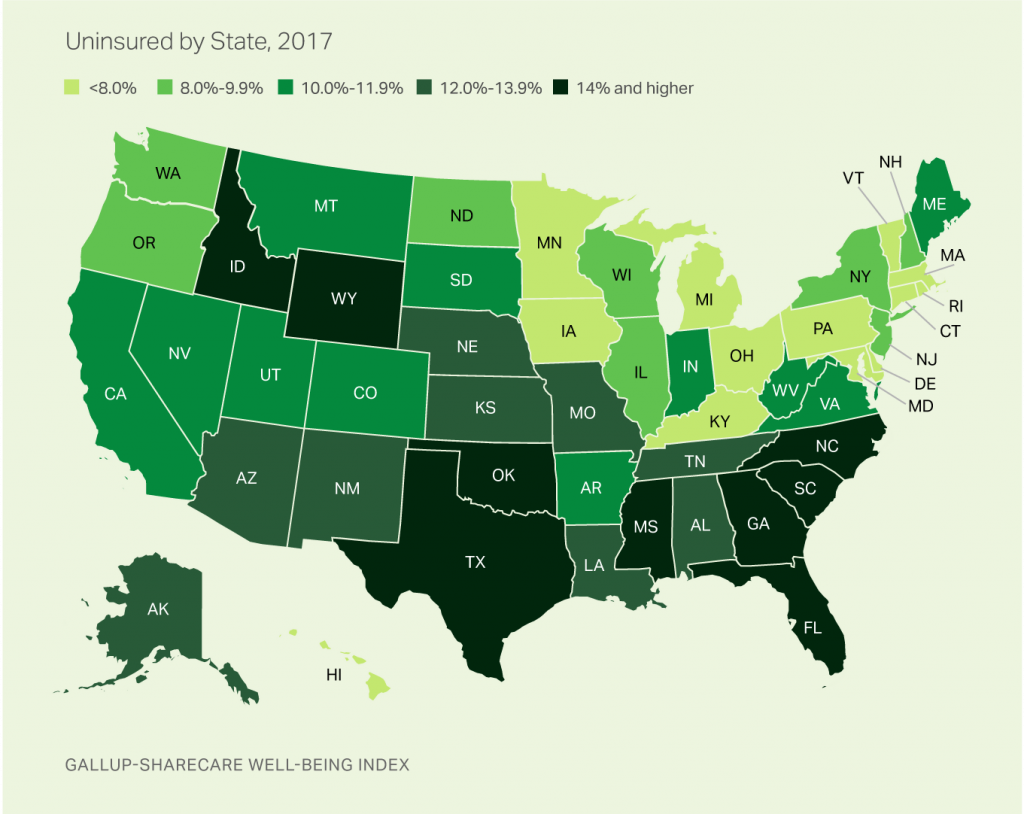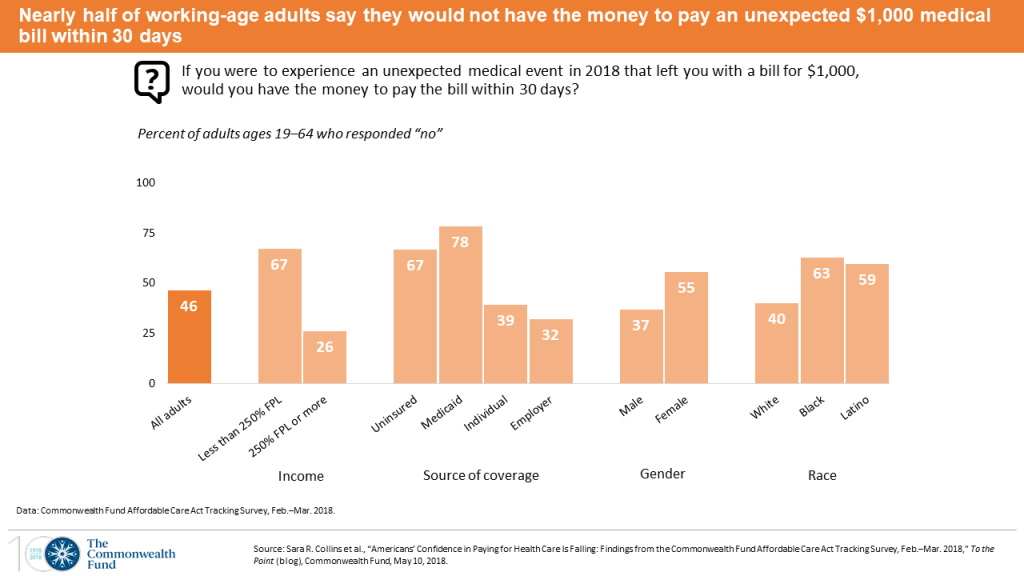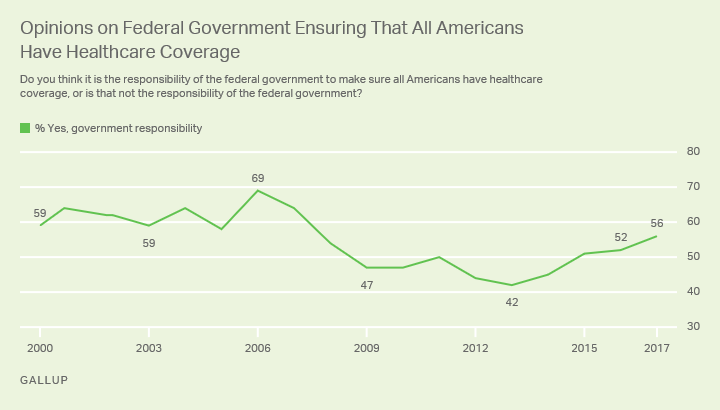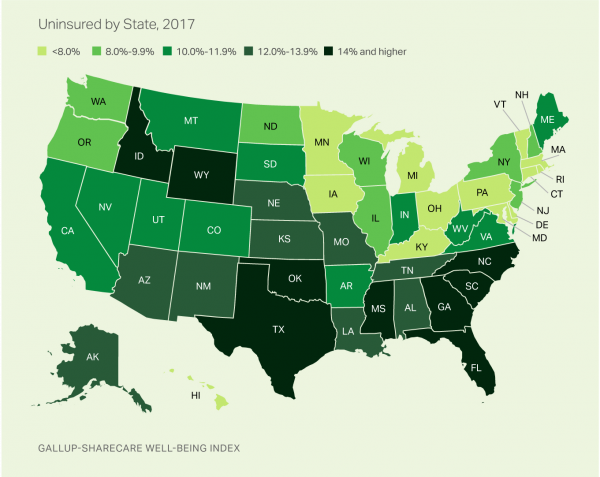 The rolls of the uninsured are growing in America, the latest Gallup-Sharecare Poll indicates. The U.S. uninsurance rate rose to 12.2% by the fourth quarter of 2017, up 1.3 percentage points from the year before.
The rolls of the uninsured are growing in America, the latest Gallup-Sharecare Poll indicates. The U.S. uninsurance rate rose to 12.2% by the fourth quarter of 2017, up 1.3 percentage points from the year before.
2017 reversed advancements in health insurance coverage increases since the advent of the Affordable Care Act, and for the first time since 2014 no states’ uninsured rates fell.
The 17 states with declines in insurance rates were Arizona, Colorado, Florida, Hawaii, Illinois, Indiana, Iowa, Missouri, New Mexico, New York, North Carolina, South Carolina, Texas, Utah, Washington, West Virginia, Wisconsin, and Wyoming.
Among these, the greatest losses of health insurance were for people living in West Virginia with the greatest drop of 4.2%, New Mexico falling 3.8%, and Hawaii and Iowa declining 3.3%.
Texas wins the award for the greatest percent of uninsured people at 22.1%. For ten years in the Gallup research, Texas has reigned the state with the highest level of the uninsured.
Massachusetts gets the nod for lowest level of uninsured at 4.0% (thank you, Romneycare, which was a model for the Affordable Care Act).
This research is part of the ongoing Gallup-Sharecare Well-Being Index surveys conducted every day, tracking questions for U.S. adults 18 and over.
Health Populi’s Hot Points: It’s insightful and correct that Gallup posts this survey on the uninsured under the tab, “Well-Being.”
That’s because being health-insured is a social determinant of health. As Dr. Vivek Murthy pointed out in his talk at the PwC 180 Health Forum earlier this week, there are six categories of #SDOH:
- Economic stability, including housing, financial wellness and debt
- Neighborhood and physical environment, such as housing safety, walkability, utilities
- Education, arguably the big kahuna here, covering literacy and early childhood education which has proved to strongly correlate to health
- Food security, increasingly recognized as central to health
- Community and social factors, especially social connections, and
- Healthcare system factors, such as health insurance coverage.
So having health insurance in America is a social determine for individuals’ health like access to healthy food, clean water (THINK: Flint), and living in safe housing.
 This week, the Commonwealth Fund points out Americans’ falling confidence in their ability to pay for healthcare. One-third of people with individual health insurance coverage told the Fund their healthcare has become harder to afford over the past 12 months. This bar chart shows that 50% of working-age adults would not have sufficient funds to pay an unexpected $1,000 medical bill within 30 days.
This week, the Commonwealth Fund points out Americans’ falling confidence in their ability to pay for healthcare. One-third of people with individual health insurance coverage told the Fund their healthcare has become harder to afford over the past 12 months. This bar chart shows that 50% of working-age adults would not have sufficient funds to pay an unexpected $1,000 medical bill within 30 days.
We imminently await President Trump’s and Secretary of Health and Human Services Alex Azar’s proposed plans to reduce the cost of prescription drugs, which is a “tri-partisan” issue with which Democrats, Independents, and Republicans all agree is due for increased Federal regulation.
President Trump campaigned on this issue and was quoted in his TIME magazine “Person of the Year” profile saying, “we have to…create new bidding procedures for the drug industry, because they’re getting away with murder, pharma. Pharma has a lot of lobbies, a lot of lobbyists, a lot of power. And there’s very little bidding on drugs.”
Remember that prescription drug spending continues to hover around one-tenth of overall U.S. National Health Expenditures. A move to re-align prescription drug prices will be welcomed across the political spectrum as Big Pharma continues to take the bulk of the blame for rising healthcare costs. But actually, “it’s the prices, stupid” across the entire healthcare system that plague, ultimately, the patient-as-payor including but not limited to insurance premium costs, hospital and physician bills, and to be sure, prescription drugs.
 As a final reminder, most Americans are looking for the Federal government to ensure that every U.S. health citizen is covered by health insurance. I’m just the messenger – this was the Gallup-Sharecare research findings from December 2017. Just sayin’.
As a final reminder, most Americans are looking for the Federal government to ensure that every U.S. health citizen is covered by health insurance. I’m just the messenger – this was the Gallup-Sharecare research findings from December 2017. Just sayin’.





 Thank you, Jared Johnson, for including me on the list of the
Thank you, Jared Johnson, for including me on the list of the  I am so grateful to Tom Lawry for asking me to pen the foreword for his book, Health Care Nation,
I am so grateful to Tom Lawry for asking me to pen the foreword for his book, Health Care Nation,  Thanks to Feedspot for naming this blog, Health Populi, as a
Thanks to Feedspot for naming this blog, Health Populi, as a